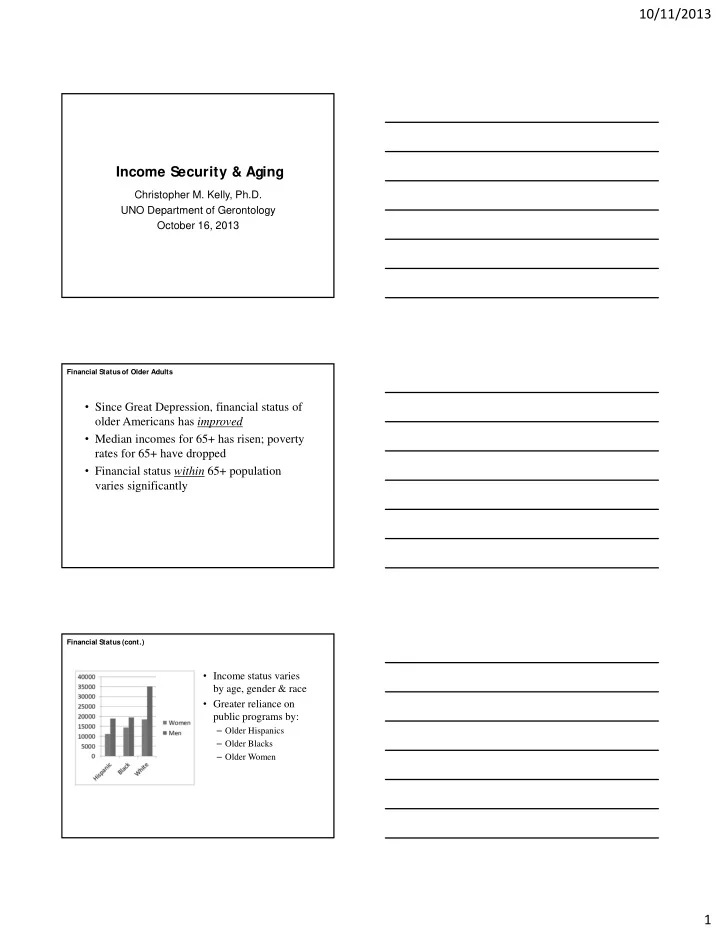

10/11/2013 Income Security & Aging Christopher M. Kelly, Ph.D. UNO Department of Gerontology October 16, 2013 Financial Status of Older Adults • Since Great Depression, financial status of older Americans has improved • Median incomes for 65+ has risen; poverty rates for 65+ have dropped • Financial status within 65+ population varies significantly Financial Status (cont.) • Income status varies by age, gender & race • Greater reliance on public programs by: – Older Hispanics – Older Blacks – Older Women 1
10/11/2013 3-Legged Stool • Primary sources of financial security in retirement in U.S. • Consists of: – Social Security – Private Pensions – Savings & Assets • Social Security not meant to be sole source of income S ocial S ecurity in U.S . • U.S. old age pension, created in 1935 • An “earned benefit” (unlike programs in other countries) • Today, 3 types of benefits: – Retirement – Survivors – Disability Retirement Benefits (1935) • Coverage is nearly universal for work done in U.S. (95% of all jobs) • 40 quarters (10 years) of paid work are required in order to qualify for benefits • Covered employment: all work as a paid employee (includes self-employment) • Earnings limit eliminated in 2000 (persons age 65+ can work & receive Social Security benefits) 2
10/11/2013 Retirement Benefits (cont.) • Benefit based on previous income • Automatic cost-of- living adjustments (COLAs) since 1973 • Redistributive: lower wage workers receive higher rate of return Eligibility for Full Benefits Worked 10 years in covered employment • Born before 1940? – Age 65 • Born 1940-1960? – Eligibility age gradually increases from 65-67 • Born after 1960? – Age 67 S ocial S ecurity Early Retirement (1961) • Partial benefits are available at age 62 if you have worked for 10 years • If you take early retirement, your benefits will be permanently reduced • Amount about 85% of full retirement benefits (i.e., if you had waited until 65) 3
10/11/2013 S urvivors Benefits (1939) • Continued benefits for dependents of deceased workers • Who’s eligible? – Widowed spouses + children (including divorced spouses) – Who have not worked for 10 years Disability Benefits (1956) • For workers of any age who are: – Permanently disabled – Unable to work • Problem: difficult to qualify today Social Security Financing • Benefits financed by payroll taxes on current workers • Payroll tax (FICA): employee pays: – 7.65% of first $110,100 of annual income • 6.20% for Social Security • 1.45% for Medicare – Employer matches this amount • Today: SS Trust Fund has a surplus – $461 billion going out – $642 billion coming in 4
10/11/2013 Future of Social Security • Today under law , SS benefits are insured for 75 years (Social Security Act of 1935) • Problems: – Between 2011-2029, an increasing strain on SS trust fund (benefits for baby boomers) – U.S. Government has borrowed from SS trust fund to pay other expenses – To maintain benefits at current levels, payroll taxes will have to be increased Proposals to Fix S ocial S ecurity • Current debate on entitlement reform began in 1990s • Two types of changes discussed today – Radical (privatization) – Incremental Privatization • 2005: President Bush proposed creating Personal Retirement Accounts (was not passed by Congress) • Would have allowed workers to shift payroll taxes: from Social Security trust fund to private account • Would have changed the goal of Social Security: from economic security to maximization of return 5
10/11/2013 Incremental Changes Possibilities include: 1. Raise eligibility age for full benefits 2. Increase payroll tax on all workers 3. Raise taxable earnings ceiling 4. Decrease benefits Why should we fix Social Security? Popularity due to: • Security – Protects seniors from economic uncertainty – Is reliable • Dignity – Protects self-reliance & independence – Is not “welfare” Supplemental Security Income (1972) • Federal income program funded by general tax revenues • States can issue additional benefits; but cannot change federal eligibility rules • Means-tested: must have income below federal eligibility level – $2000/year (individual) – $3000/year (couple) 6
10/11/2013 Pensions • Provide an additional source of income for people no longer in employment • May be set up by employers, employees, insurance companies, or government (example: public pensions) • Today: 2 major types of private pension plans: – Defined Benefit – Defined Contribution Defined Benefit • Majority of pension plans before 1980 • Set amount paid by employer each month (based on earnings, years of service) • Employer’s responsibility to set aside funds & invest wisely Defined Contribution • Majority of pension plans today (i.e., 401(k); IRAs) • Stock dividend; pension is based on the employee’s investments • Employee’s responsibility to make regular payments into his/her own account 7
10/11/2013 S avings & Assets • Higher-income older adults rely more on savings & assets for income • Assets include: stocks & bonds, checking & savings accounts, business income (including rental income) • For most older adults, the most valuable asset is their home (a source of income through reverse mortgage) Financial Counseling • Available to age 50+ at Area Agencies on Aging (AAAs) • Free counseling includes: 1. Investments 2. Housing (including reverse mortgages) 3. Banking & credit card (including fraud) 4. Health care (including power of attorney) Questions Christopher M. Kelly, Ph.D. Associate Professor Department of Gerontology UNO, CB 210H UNL, NH 338 402-554-4124 (UNO) 402-472-4317 (UNL) cmkelly@unomaha.edu 8
Recommend
More recommend